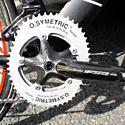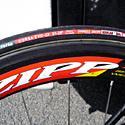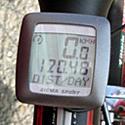
Recently on Cyclingnews.com |
Pro bike: March 13, 2005
Bobby Julich's CSC Cervélo Soloist
Paris-Nice warriorBy John Stevenson As the final day of Paris-Nice dawns, American CSC rider Bobby Julich looks likely to hang on to the overall lead that he took on stage five - at least if Bjarne Riis' powerful and dedicated team has anything to say about it. The bike that has carried Julich to this point is one of the team's fleet of 2005 model Cervélos. But rather than the super-light R2.5 Bayonne or the new R2.5 carbon, Julich has been aboard a Soloist, one of the most affordable frames in the Cervélo range. Bjarne Riis is famously exacting about the equipment his riders use, and the team's relationship with Cervélo has clearly befitted both parties. Headed by designers Gerard Vroomen and Phil White, the bike maker is famously dedicated to engineering mystique-free machines; many of the company's bikes are made in Taiwan, but Vroomen and White keep a very tight rein on the quality. As Vroomen pragmatically said in an interview with Cyclingnews last year, "Giant will always beat you on price thanks to their volume. So if you cannot be the cheapest, you need to be the best." He added, "Not all our frames are made in Taiwan. It really depends from model to model. For example, Bobby’s P3 (time trial machine) is made in the US, some other frames are made in Canada, it all depends on what we are trying to accomplish." Julich's Soloist is hung with CSC's standard equipment package (we'll get to that in a moment) but with one dramatic difference. Julich uses French O.Symetric Harmonic elliptical chainrings, a component selection that we always get letters about whenever we run a clear side-on pic of Julich's bike. To get the obvious question out of the way, this isn't a resurrection of Shimano's Biopace rings of the 1980s. An elliptical chainring changes the effective gear ratio as you pedal. Biopace reduced the gear ratio as crank passed through the horizontal; the O.Symetric Harmonic increases it. The idea is that the sector of the pedal stroke where the crank is horizontal or nearly so is where you can push hardest, so it makes sense to increase the gear at that point, then drop it to get your foot through top and bottom dead center quickly. It's the same idea as British component maker Chris Bell's Eggrings and, well, just about every other inventor who has come up with elliptical chainrings since shortly after chain drives were invented. However, while the idea has come and gone many times in the last 100 years or so, it clearly seems to work for Bobby Julich, who has used the O.Symetric rings to land an Olympic bronze medal, and to contribute to CSC's team time trial victory in the Tour Méditerranéen. The O.Symetric rings are mounted on 172.5mm FSA Superlight cranks, a monocoque carbon fiber crank that turns on an oversized ISIS spline bottom bracket. At the ends of the cranks are Speedplay pedals, long a CSC team pick. The rest of Julich's transmission is Shimano Dura-Ace ten-speed: the front and rear derailleurs, chain, and sprockets all come from Osaka, as do the brake/shift levers and brakes. However, the increased power that those rings seem to help Julich produce gets to the ground via Vittoria Corsa Evo CX 21mm tubulars on Zipp 404 wheels, a spec that seems to imply Julich has picked up on something a few aerodynamics experts have recently begun to hint at: wheel aerodynamics is an advantage in the bunch as well as in a time trial or solo break away. The theory goes like this. You may be able to sit behind another rider in a peloton (especially if you're the race leader and your entire team is working for you!) but your wheels still go round, and they still hack up the air as they churn through it. Aero wheels require less effort to turn , so, in terms of the energy you save (and can therefore conserve for climbing efforts), they may be more of an advantage in a pack than used to be thought. We return to FSA for Julich's steering. His 42cm (centre to centre) FSA RD-200 handlebar is almost old school in these days of carbon bars, but at a claimed weight of 215g, it's still one of the lightest bars around thanks to FSA's use of high-strength 7050 aluminium. It's mounted in a 130mm FSA OS115 stem with titanium bolts and carbon fiber front cap, and both bar and stem are 31.8mm clamp. A stem-mounted Sigma Sport computer keeps track of distance, speed and time. At the remaining contact point with the bike, Julich sits on a Selle Italia Max Flite which is atop Cervélo's own aero seatpost, essential for the Soloist's aero seat tube. PhotosFor a thumbnail gallery of these images, click here Images by Hedwig Kroner/Cyclingnews
| |||||||







